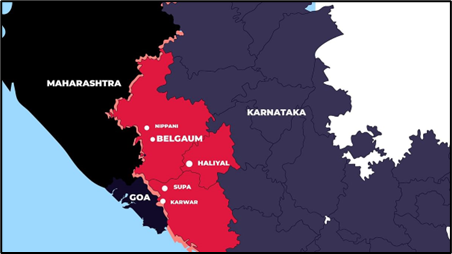Why in news?
- The border dispute between Maharashtra and Karnataka is intensifying, with both states hardening their stance.
- Recently, both Houses of the Maharashtra Assembly passed a unanimous resolution to support a legal battle to resolve the dispute.
What’s in today’s article:
- Maharashtra-Karnataka border dispute
- News Summary
Maharashtra-Karnataka border dispute
Historical Background:

- The Maharashtra and Karnataka boundary dispute has its origins in the reorganisation of states along linguistic lines via the State Reorganisation Act, 1956.
- This Act, which took effect from 1 November, 1956, divided states on linguistic lines.
- Since its creation on May 1, 1960, Maharashtra has claimed that 865 villages, including Belagavi (then Belgaum), Carvar and Nipani, should be merged into Maharashtra.
- Maharashtra claims that these are the regions where Marathi is the dominant language, should remain in Maharashtra.
- Karnataka, however, has refused to part with its territory.
Mahajan Commission:
- In October, 1966, the Centre constituted the Mahajan Commission headed by the then Supreme Court Chief Justice Meher Chand Mahajan, at the insistence of Maharashtra.
- Commission’s recommendations –
- While rejecting Maharashtra’s claim over Belagavi (then Belgaum), the commission recommended 247 villages/places, including Jatt, Akkalkote and Solapur, to be made part of Karnataka.
- It also declared 264 villages /places, including Nippani, Khanapur and Nandagad, to be made part of Maharashtra.
- However, the commission’s report was outrightly rejected by Maharashtra, and in 2004, it moved the Supreme Court.
News Summary:
How are disputes between states resolved in India?
- Centre as a neutral mediator
- Attempts are often made to resolve inter-state disputes with the cooperation of both sides, with the Centre working as a facilitator or a neutral mediator.
- For example, in current case between Maharashtra and Karnataka, Union Home Minister met both the Chief Ministers and asked them to form a six-member team to address all boundary issues.
- If issues are resolved amicably, Parliament can bring a law to alter state boundaries.
- Eg., Bihar-Uttar Pradesh (Alteration of Boundaries) Act of 1968 and the Haryana-Uttar Pradesh (Alteration of Boundaries) Act of 1979 was brought in similar fashion.
- Judicial redressal
- The Supreme Court in its original jurisdiction decides disputes between states.
- Article 131 of the Constitution allows SC to have original jurisdiction in any dispute:
- between the Government of India and one or more States; or
- between the Government of India and any State or States on one side and one or more other States on the other; or
- between two or more States.
- Inter-state Council
- Article 263 of the Constitution gives powers to the President to set up an Inter-state Council for resolution of disputes between states.
- The Council is envisaged as a forum for discussion between the states and the Centre.
- In 1988, the Sarkaria Commission suggested that the Council should exist as a permanent body, and in 1990 it came into existence through a Presidential Order.
- In 2021, the Centre reconstituted the Inter-state Council and the body now has 10 Union Ministers as permanent invitees.
- The standing committee of the Council has been reconstituted with Home Minister as Chairman.









